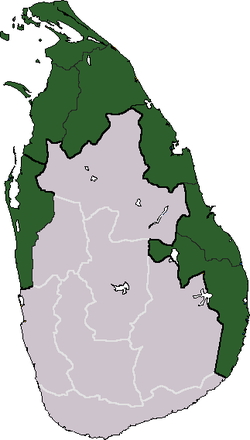Tamil Eelam
|
Tamil Eelam தமிழீழம் |
|
|---|---|
| Aspirational state | |
| Tamil Eelam | |
| Anthem: Eruthu Paar Kodi Look the Flag is Rising |
|
 Area that is claimed for Tamil Eelam |
|
| Coordinates: 08°45′N 80°30′E / 8.750°N 80.500°ECoordinates: 08°45′N 80°30′E / 8.750°N 80.500°E | |
| Capital | Trincomalee |
| Largest City | Trincomalee |
| Districts | |
| Area | |
| • Total | 21,952 km2 (8,476 sq mi) |
| • Land | 20,533 km2 (7,928 sq mi) |
| • Water | 1,419 km2 (548 sq mi) 6.46% |
| Population (2009) | |
| • Total | 3,496,000 |
| • Density | 160/km2 (410/sq mi) |
| Ethnicity(1981) | |
| • Eelam Tamil | 1,189,000 (1981) – 1,388,828 (2001) |
| • Sinhalese | 45,000 (1981) – 685,896 (2011) |
| • Moor | 415,267 (16.11%) |
| • Indian Tamil | 76,905 (2.98%) |
| • Other | 10,292 (0.40%) |
| Religion(1981) | |
| • Hindu | 1,251,742 (48.57%) |
| • Buddhist | 498,938 (19.36%) |
| • Muslim | 422,239 (16.38%) |
| • Catholic | 381,679 (14.81%) |
| • Other | 22,590 (0.88%) |
| Official Languages | Tamil |
Tamil Eelam (Tamil: தமிழீழம் tamiḻ īḻam, generally rendered outside Tamil-speaking areas as தமிழ் ஈழம்) is a proposed independent state that Tamils in Sri Lanka and the Sri Lankan Tamil diaspora aspire to create in the north and east of Sri Lanka. Tamil Eelam has no official status or recognition by world states though sections of the Eelam were under de facto control of the Liberation Tigers of Tamil Eelam (LTTE) for most of the 2000s. The name is derived from the ancient Tamil name for Sri Lanka, Eelam.
Evidence of a settlement of people with burial practices similar to that found in the Tamil Nadu region in India and further North was excavated at megalithic burial sites at Pomparippu in the western coast and in Kathiraveli in the eastern coast. These are dated between 2nd century BC and 2nd century AD. Although it is not known when ethnic Tamils first settled in Sri Lanka. Tamil royal dynasties in this period are known to have patronized Tamil Saivite culture in the east that paralleled the growth of the community in the area, and by the 6th century, a special coastal route by boat was functioning to the Koneswaram temple of Trincomalee and Thirukkovil Sithira Velayutha Swami Kovil in Batticaloa. It wasn't until the 13th century that there was firm evidence of the rise of a significant Tamil Hindu social formation in the Jaffna Peninsula, the Jaffna Kingdom, in the aftermath of the collapse of the classical Sinhala Dry Zone civilisations. By the 11th and 12th centuries AD the upper half of the eastern province had a large Tamil community.
...
Wikipedia
